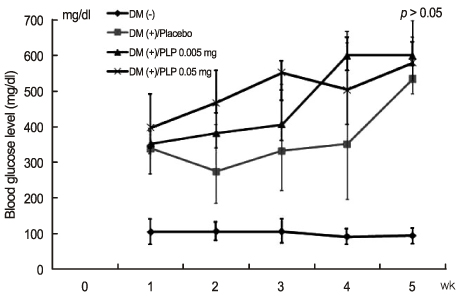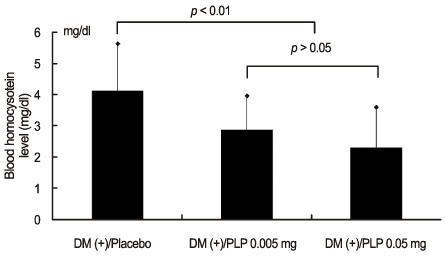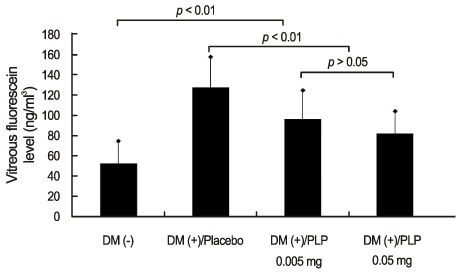J Korean Ophthalmol Soc.
2012 May;53(5):700-706.
Suppression of VEGF and Decrease in Vascular Leakage by Pyridoxal 5'-Phosphate in Diabetic Rats
- Affiliations
-
- 1Department of Ophthalmology, Kangdong Sacred Heart Hospital, Hallym University College of Medicine, Seoul, Korea. sungpyo@hanafos.com
- 2Department of Ophthalmology, Seoul National University College of Medicine, Seoul, Korea.
- 3Seoul Artificial Eye Center, Seoul National University Hospital Clinical Research Institute, Seoul, Korea.
Abstract
- PURPOSE
The authors of the present study investigated whether pyridoxal 5'-phosphate (PLP), an active coenzyme of vitamin B6, could inhibit the development of diabetic retinopathy in streptozotocin (STZ)-induced diabetic rats.
METHODS
Seven-week-old Spraque-Dawley rats (n = 20) were used in the present study. STZ (70 mg/kg) was injected intraperitoneally to induce diabetes. Blood glucose and body weight were monitored. Intraperitoneal injections of 5 microg and 50 microg PLP were administered every two days from the second week of induced diabetes. During the third week of PLP injections, the concentration level of plasma homocysteine was measured. In addition, functional status was examined by vitreous fluorophotometer and anatomical status by vascular endothelial growth factor (VEGF) staining in the retina.
RESULTS
Based on vitreous fluorophotometry examination, the PLP injection group proved to have a lower level of fluorescein concentration in the vitreous. Additionally, immunohistochemical staining revealed down-regulation of VEGF expression in the PLP group. In addition, the PLP group had a lower plasma homocysteine concentration. However, an over-dosage injection of PLP did not appear to have any noticeable impact on the treatment of diabetes.
CONCLUSIONS
PLP, an active coenzyme of vitamin B6, proved to have inhibitory effects on VEGF expression and vascular leakage in the diabetic rat retina.
Keyword
MeSH Terms
-
Animals
Blood Glucose
Body Weight
Diabetic Retinopathy
Down-Regulation
Fluorescein
Fluorophotometry
Homocysteine
Injections, Intraperitoneal
Plasma
Pyridoxal
Rats
Retina
Streptozocin
Vascular Endothelial Growth Factor A
Vitamin B 6
Blood Glucose
Fluorescein
Homocysteine
Pyridoxal
Streptozocin
Vascular Endothelial Growth Factor A
Vitamin B 6
Figure
Reference
-
1. Amos AF, McCarthy DJ, Zimmet P. The rising global burden of diabetes and its complications: estimates and projections to the year 2010. Diabet Med. 1997. 14:Suppl 5. S1–S85.2. Marshall SM, Flyvbjerg A. Prevention and early detection of vascular complications of diabetes. BMJ. 2006. 333:475–480.3. Curtis TM, Gardiner TA, Stitt AW. Microvascular lesions of diabetic retinopathy: clues towards understanding pathogenesis? Eye (Lond). 2009. 23:1496–1508.4. Nishikawa T, Edelstein D, Du XL, et al. Normalizing mitochondrial superoxide production blocks three pathways of hyperglycaemic damage. Nature. 2000. 404:787–790.5. Brownlee M. Biochemistry and molecular cell biology of diabetic complications. Nature. 2001. 414:813–820.6. Van Hecke MV, Dekker JM, Nijpels G, et al. Inflammation and endothelial dysfunction are associated with retinopathy: the Hoorn Study. Diabetologia. 2005. 48:1300–1306.7. Schram MT, Chaturvedi N, Schalkwijk CG, et al. Markers of inflammation are cross-sectionally associated with microvascular complications and cardiovascular disease in type 1 diabetes-- the EURODIAB Prospective Complications Study. Diabetologia. 2005. 48:370–378.8. Brazionis L, Rowley K Sr, Itsiopoulos C, et al. Homocysteine and diabetic retinopathy. Diabetes Care. 2008. 31:50–56.9. UK Prospective Diabetes Study (UKPDS) Group. Intensive blood-glucose control with sulphonylureas or insulin compared with conventional treatment and risk of complications in patients with type 2 diabetes (UKPDS 33). Lancet. 1998. 352:837–853.10. Yamagishi S, Matsui T, Nakamura K, et al. Pigment-epithelium-derived factor suppresses expression of receptor for advanced glycation end products in the eye of diabetic rats. Ophthalmic Res. 2007. 39:92–97.11. Kowluru RA, Odenbach S. Effect of long-term administration of alpha-lipoic acid on retinal capillary cell death and the development of retinopathy in diabetic rats. Diabetes. 2004. 53:3233–3238.12. Bursell SE, Clermont AC, Aiello LP, et al. High-dose vitamin E supplementation normalizes retinal blood flow and creatinine clearance in patients with type 1 diabetes. Diabetes Care. 1999. 22:1245–1251.13. Kim ES, Yu SY, Kwon SJ, et al. Clinical evaluation of patients with monproliferative diabetic retinopathy following medication of anthocyanoside: multicenter study. J Korean Ophthalmol Soc. 2008. 49:1629–1633.14. Yu SI, Jung HJ, Her DY, et al. Suppression of VEGF and STAT3 by lipoic acid in experimental diabetic rat retina. J Korean Ophthalmol Soc. 2007. 48:715–724.15. Okada M, Shibuya M, Yamamoto E, Murakami Y. Effect of diabetes on vitamin B6 requirement in experimental animals. Diabetes Obes Metab. 1999. 1:221–225.16. Toyota T, Kai Y, Kakizaki M, et al. The endocrine pancreas in pyridoxine deficient rats. Tohoku J Exp Med. 1981. 134:331–336.17. Araki A. Homocysteine and diabetic macroangiopathy. Nihon Rinsho. 2006. 64:2153–2158.18. Cunha-Vaz JG, Gray JR, Zeimer RC, et al. Characterization of the early stages of diabetic retinopathy by vitreous fluorophotometry. Diabetes. 1985. 34:53–59.19. Van Schaik HJ, Benitez del Castillo JM, Caubergh MJ, et al. Evaluation of diabetic retinopathy by fluorophotometry. european concerted action on ocular fluorometry. Int Ophthalmol. 1998-1999. 22:97–104.20. Do carmo A, Ramos P, Reis A, et al. Breakdown of the inner and outer blood retinal barrier in streptozotocin-induced diabetes. Exp Eye Res. 1998. 67:569–575.21. Anis HH, Bahgat M, Peyman GA, et al. Effect of pyridoxine on the blood-retina barrier in experimentally induced hyperglycemia in rats. Can J Ophthalmol. 1991. 26:354–357.22. Castro R, Rivera I, Blom HJ, et al. Homocysteine metabolism, hyperhomocysteinaemia and vascular disease: an overview. J Inherit Metab Dis. 2006. 29:3–20.23. Lominadze D, Roberts AM, Tyagi N, et al. Homocysteine causes cerebrovascular leakage in mice. Am J Physiol Heart Circ Physiol. 2006. 290:H1206–H1213.24. Moshal KS, Sen U, Tyagi N, et al. Regulation of homocysteine-induced MMP-9 by ERK1/2 pathway. Am J Physiol Cell Physiol. 2006. 290:C883–C891.25. Aydemir O, Turkcuoglu P, Guler M, et al. Plasma and vitreous homocysteine concentrations in patients with proliferative diabetic retinopathy. Retina. 2008. 28:741–743.26. Brazionis L, Rowley K Sr, Itsiopoulos C, et al. Homocysteine and diabetic retinopathy. Diabetes Care. 2008. 31:50–56.27. Adamis AP, Miller JW, Bernal MT, et al. Increased vascular endothelial growth factor levels in the vitreous of eyes with proliferative diabetic retinopathy. Am J Ophthalmol. 1994. 118:445–450.28. Aiello LP, Avery RL, Arrigg PG, et al. Vascular endothelial growth factor in ocular fluid of patients with diabetic retinopathy and other retinal disorders. N Engl J Med. 1994. 331:1480–1487.29. Mathews MK, Merges C, McLeod DS, Lutty GA. Vascular endothelial growth factor and vascular permeability changes in human diabetic retinopathy. Invest Ophthalmol Vis Sci. 1997. 38:2729–2741.30. Higuchi O, Nakagawa K, Tsuzuki T, et al. Aminophospholipid glycation and its inhibitor screening system: a new role of pyridoxal 5'-phosphate as the inhibitor. J Lipid Res. 2006. 47:964–974.31. Padayatti PS, Jiang C, Glomb MA, et al. High concentrations of glucose induce synthesis of argpyrimidine in retinal endothelial cells. Curr Eye Res. 2001. 23:106–115.32. Canning P, Glenn JV, Hsu DK, et al. Inhibition of advanced glycation and absence of galectin-3 prevent blood-retinal barrier dysfunction during short-term diabetes. Exp Diabetes Res. 2007. 2007:51837.33. Moore TC, Moore JE, Kaji Y, et al. The role of advanced glycation end products in retinal microvascular leukostasis. Invest Ophthalmol Vis Sci. 2003. 44:4457–4464.34. Kiran SG, Dorisetty RK, Umrani MR, et al. Pyridoxal 5' phosphate protects islets against streptozotocin-induced beta-cell dysfunction--in vitro and in vivo. Exp Biol Med (Maywood). 2011. 236:456–465.35. Chen BH, Jiang DY, Tang LS. Advanced glycation end-products induce apoptosis involving the signaling pathways of oxidative stress in bovine retinal pericytes. Life Sci. 2006. 79:1040–1048.36. Yamagishi S, Fujimori H, Yonekura H, et al. Advanced glycation endproducts accelerate calcification in microvascular pericytes. Biochem Biophys Res Commun. 1999. 258:353–357.37. Stitt A, Gardiner TA, Alderson NL, et al. The AGE inhibitor pyridoxamine inhibits development of retinopathy in experimental diabetes. Diabetes. 2002. 51:2826–2832.
- Full Text Links
- Actions
-
Cited
- CITED
-
- Close
- Share
- Similar articles
-
- Suppression of VEGF and STAT3 by Lipoic acid in Experimental Diabetic Rat Retina
- Effects of citrate pyridoxal 5'-phosphate-TRIS(CPT) antivoagulant on spurious low platelet counts caused by EDTA
- Chlorogenic Acid Decreases Retinal Vascular Hyperpermeability in Diabetic Rat Model
- Vascular Endothelial Growth Factor (VEGF) and Advanced Glycation End Products (AGEs) Overexpression in the Retina and Serum and Lens Opacities of Streptozotocin-induced Diabetic Rats
- Immunohistochemical Study of Transforming Growth Factor-beta2(TGF-beta2) and Vascular Endothelial Growth Factor(VEGF) after Laser Photocoagulation in the Ocular Tissues of White Rats






